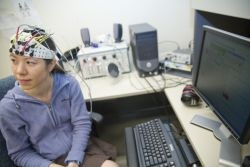Reading minds with infrared scan
Researchers at Canada's largest children's rehabilitation hospital have developed a technique that uses infrared light brain imaging to decode preference — with the goal of ultimately opening the world of choice to children who can't speak or move. Using optical brain imaging, the scientists decode preference with 80 per cent accuracy.

In a study published this month in The Journal of Neural Engineering, Bloorview scientists demonstrate the ability to decode a person’s preference for one of two drinks with 80 per cent accuracy by measuring the intensity of near-infrared light absorbed in brain tissue. www.iop.org/EJ/abstract/1741-2552/6/1/016003
“This is the first system that decodes preference naturally from spontaneous thoughts,” says Sheena Luu, the University of Toronto PhD student in biomedical engineering who led the study under the supervision of Tom Chau, Canada Research Chair in pediatric rehab engineering.
Most brain-computer interfaces designed to read thoughts require training. For example, in order to indicate yes to a question, the person needs to do an unrelated mental task – such as singing a song in their head.
The nine adults in Luu’s study received no training. Prior to the study they rated eight drinks on a scale of one to five.
Wearing a headband fitted with fibre-optics that emit light into the pre-frontal cortex of the brain, they were shown two drinks on a computer monitor, one after the other, and asked to make a mental decision about which they liked more.
“When your brain is active, the oxygen in your blood increases and depending on the concentration, it absorbs more or less light,” Luu says. “In some people, certain parts of their brains are more active when they don’t like something, and in some people they’re more active when they do like something.”
After teaching the computer to recognize the unique pattern of brain activity associated with preference for each subject, the researchers accurately predicted which drink the participants liked best 80 per cent of the time.
“Preference is the basis for everyday decisions,” Luu says. When children with disabilities can’t speak or gesture to control their environment, they may develop a learned helplessness that impedes their development.
In future, Luu envisions creating a portable, near-infrared sensor that rests on the forehead and relies on wireless technology, opening up the world of choice to children who can’t speak or move.
Her work is part of Tom Chau’s body-talk research, which aims to give children who are “locked in” by disability a way to express themselves through subtle body processes like breathing pattern, heart rate and brain activity.
Luu notes that the brain is too complex to ever allow decoding of a person’s random thoughts. “However, if we limit the context – limit the question and available answers, as we have with predicting preference – then mind-reading becomes possible.”
Picture: Bloorview Kids Rehab
19.02.2009











